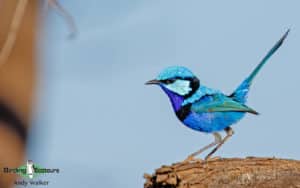Birdwatching in Australia offers one of the most rewarding experiences for nature lovers, with over 850 bird species spread across the country’s diverse landscapes. From lush rainforests and coastal wetlands to arid deserts and highland regions, Australia provides a unique habitat for a wide range of birds, including iconic species like the laughing kookaburra, wedge-tailed eagle, and superb fairy-wren. The country is home to approximately 45% of endemic bird species, making it a global hotspot for avian diversity. Organizations like BirdLife Australia actively work to protect these species, ensuring that future generations can continue to enjoy birdwatching in this vast and ecologically rich land.
Australia’s strategic location also makes it a vital destination for migratory birds traveling along the East Asian-Australasian Flyway, a crucial migratory route connecting the Arctic, Asia, and the southern hemisphere. Wetlands such as Kakadu National Park and Broome’s Roebuck Bay serve as key stopover points for species like the bar-tailed godwit, which holds the record for the longest non-stop migration, covering over 11,000 kilometers from Alaska. This extraordinary phenomenon has been extensively studied by Australia’s National Environmental Science Program, which monitors migratory bird populations and their changing habitats.
The economic impact of birdwatching in Australia is significant, with ecotourism contributing over $280 million annually, according to Tourism Australia. Many birdwatching tours, ranging from guided rainforest explorations to remote outback expeditions, attract thousands of international visitors each year. Popular destinations include Queensland’s Daintree Rainforest, which harbors rare species such as the double-eyed fig parrot, and Tasmania’s Bruny Island, home to endemic birds like the forty-spotted pardalote. Tour operators and conservation groups, including Australian Wildlife Journeys, offer customized birdwatching experiences, highlighting the importance of sustainable tourism in protecting Australia’s avian biodiversity.
The Australian outback presents a unique opportunity to observe some of the world’s most resilient bird species. Arid regions like Alice Springs and the Simpson Desert support species such as the budgerigar and spinifex pigeon, which have adapted to harsh conditions with remarkable survival strategies. Conservation organizations like Bush Heritage Australia actively work to restore and protect these fragile ecosystems, ensuring that these species continue to thrive despite climate change challenges. Similarly, the Australian National Parks and Wildlife Service manages protected areas, preserving vital bird habitats across the continent.
For those interested in shorebirds and seabirds, Australia’s extensive coastline offers an exceptional birdwatching experience. Locations such as Western Australia’s Shark Bay and Victoria’s Phillip Island attract thousands of species, including the little penguin, sooty oystercatcher, and the critically endangered eastern curlew. Dedicated research institutions like The Australian Bird and Bat Banding Scheme play a crucial role in tracking and conserving these species. Additionally, photography enthusiasts can capture stunning images of Australia’s unique birdlife by joining specialized tours led by Wildlife Tourism Australia, which promotes responsible wildlife viewing.
With an increasing number of citizen scientists using platforms like eBird Australia to record their sightings, birdwatching has become more accessible and impactful than ever. Whether you are an amateur or a seasoned ornithologist, the unparalleled diversity and conservation efforts in place make Birdwatching in Australia an unforgettable adventure.
A Paradise for Bird Enthusiasts: Why Australia is a Top Destination
Unique Bird Diversity in Australia
Australia is home to more than 850 bird species, with nearly 45% of them being endemic to the country. The diversity of habitats, from rainforests to arid deserts, supports an incredible range of birds, including the famous emu and the lyrebird. The rich biodiversity makes Birdwatching in Australia a unique and rewarding experience for enthusiasts worldwide.
Importance of Australia in Global Birdwatching
With over 200 species found nowhere else in the world, Australia plays a vital role in global birdwatching. The country’s distinct climatic zones allow birders to observe an extensive variety of species in different environments. Popular locations like Kakadu National Park and Daintree Rainforest attract thousands of birdwatchers annually.
Birdwatching Tourism and Economic Impact
The birdwatching industry in Australia contributes significantly to ecotourism, generating millions of dollars each year. A 2019 study estimated that birdwatching-related tourism brings in over $280 million annually, supporting conservation efforts and local communities. The industry provides jobs in guiding, accommodation, and conservation programs.
The Role of Climate and Geography
Australia’s geographical isolation has allowed its bird species to evolve uniquely. The continent’s varied climate zones, from the tropical north to the temperate south, support migratory species such as the bar-tailed godwit, which travels over 11,000 kilometers from Alaska to Australia. Birdwatching in Australia offers opportunities to witness such extraordinary migrations.
Why Australia is a Must-Visit for Birdwatchers
Australia provides an unparalleled birdwatching experience due to its combination of endemic species, varied landscapes, and organized birding trails. Locations such as Kangaroo Island, the Atherton Tablelands, and the Great Barrier Reef offer birdwatchers a range of environments to explore. Enthusiasts from around the world visit the country, drawn by its exceptional birdlife.
Iconic Australian Birds: From the Majestic Kookaburra to the Vibrant Rainbow Lorikeet
The Laughing Kookaburra: An Australian Symbol
The laughing kookaburra, a member of the kingfisher family, is one of Australia’s most recognizable birds. Known for its loud, distinctive call that resembles human laughter, it is found in woodlands, urban parks, and forests. It plays an important role in controlling insect and small reptile populations.
The Unique Plumage of the Rainbow Lorikeet
The rainbow lorikeet, with its striking mix of red, blue, green, and yellow feathers, is one of the most visually spectacular birds in Australia. Found mainly along coastal regions, it is highly social and often seen in large, noisy flocks. Birdwatching in Australia is particularly rewarding for those seeking to observe these vibrant parrots in their natural habitat.
The Wedge-Tailed Eagle: Australia’s Largest Bird of Prey
The wedge-tailed eagle, with a wingspan of up to 2.7 meters, is Australia’s largest raptor. This powerful predator is commonly seen soaring over open plains and mountainous regions. Conservation efforts have helped stabilize populations despite historical threats from habitat destruction and persecution.
The Superb Fairy-Wren: A Favorite Among Birdwatchers
Weighing just 8 to 13 grams, the superb fairy-wren is a tiny but striking bird with brilliant blue plumage in males. This species is widespread in forests, grasslands, and urban areas. Birdwatching in Australia often includes spotting these energetic birds as they forage for insects and seeds.
The Elusive Southern Cassowary
The southern cassowary, one of the world’s most dangerous birds, is a flightless species found in the rainforests of northern Queensland. Growing up to 1.8 meters tall and weighing over 50 kilograms, it plays a crucial role in seed dispersal within its habitat. Conservation efforts focus on protecting cassowary populations from habitat destruction and vehicle collisions.
Best Birdwatching Locations: From Coastal Wetlands to Remote Outback Havens
Kakadu National Park: A Wetland Bird Haven
Kakadu National Park, a UNESCO World Heritage Site, is home to over 280 bird species. Wetland areas attract migratory birds such as magpie geese, brolgas, and jabirus. The park’s diverse habitats, including floodplains and woodlands, make it one of the top destinations for Birdwatching in Australia.
Daintree Rainforest: A Tropical Bird Paradise
The Daintree Rainforest in Queensland is one of the best places to see rainforest specialists such as the double-eyed fig parrot and the spotted catbird. The lush, ancient forest supports over 430 bird species, making it a must-visit location for birdwatchers.
The Outback and Arid Zone Birds
Australia’s vast arid zones provide habitat for unique species such as the budgerigar, spinifex pigeon, and red-backed kingfisher. Birdwatching in Australia’s desert regions offers a chance to see nomadic birds that adapt to extreme conditions and seasonal water availability.
Coastal Birding: Shorebirds and Seabirds
Australia’s coastline supports millions of shorebirds, including eastern curlews, red-necked stints, and sooty oystercatchers. Sites like Broome’s Roebuck Bay and Victoria’s Western Port Bay are crucial for migratory birds traveling along the East Asian-Australasian Flyway.
Tasmania: Home of Endemic Island Birds
Tasmania offers unique birdwatching opportunities with species such as the forty-spotted pardalote, green rosella, and Tasmanian native hen. The island’s pristine wilderness areas, including Bruny Island and Cradle Mountain, provide excellent locations for observing these rare birds.
Seasonal Birdwatching: When and Where to Spot Rare and Migratory Species
Summer: Seabirds and Coastal Migrations
During summer, thousands of migratory shorebirds arrive from the Northern Hemisphere. Locations such as Moreton Bay and Darwin Harbour become hotspots for birdwatchers looking to observe species like the grey-tailed tattler and the sharp-tailed sandpiper.
Autumn: Wetland Birdwatching
Autumn is a prime time for watching waterbirds in wetlands, including pelicans, spoonbills, and black swans. The Murray-Darling Basin provides crucial stopover points for migratory species.
Winter: Birds of the Outback
During winter, arid regions of central Australia see increased bird activity as nomadic species move in search of water. The Princess Parrot and Major Mitchell’s Cockatoo are commonly sighted during this time.
Spring: Breeding Season Activity
Spring is the best time for Birdwatching in Australia, as many species engage in nesting and breeding behaviors. The Atherton Tablelands and Blue Mountains offer excellent opportunities to observe birds such as satin bowerbirds constructing intricate bowers.
Year-Round Birdwatching Hotspots
Some birdwatching locations, such as the Sydney Royal Botanic Gardens and Perth’s Kings Park, provide excellent year-round birdwatching opportunities. These areas attract resident species that remain active regardless of the season.
Essential Gear and Tips for an Unforgettable Birdwatching Experience
Choosing the Right Binoculars
Quality binoculars are essential for observing birds from a distance. A magnification of 8×42 or 10×50 is recommended for Birdwatching in Australia.
The Importance of Field Guides
A comprehensive field guide helps birdwatchers identify species accurately. Books like “The Field Guide to the Birds of Australia” by Pizzey & Knight are widely used.
Recording Observations
Many birdwatchers keep detailed logs of their sightings, either in notebooks or digital apps like eBird. Keeping records enhances the experience and contributes to citizen science.
Ethical Birdwatching Practices
Avoiding disturbance to nesting sites and following designated trails helps protect bird populations. Respecting local conservation guidelines ensures that birdwatching remains sustainable.
Best Times for Birdwatching
Early morning and late afternoon are the best times to observe birds, as they are most active during these hours. Planning visits around peak feeding times increases the chances of sightings.




